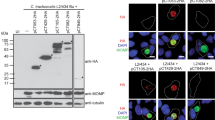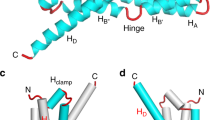Abstract
Chlamydia trachomatis resides and replicates within a membranous vacuole, termed the inclusion. A group of Type III secreted effector proteins, the inclusion membrane proteins (Inc), are embedded within the inclusion membrane and facilitate the interaction of the inclusion with host cell organelles. These interactions are vital for bacterial replication and allow for the acquisition of essential nutrients from the host cell. However, it is not known if Inc proteins function independently or require interactions with other Inc proteins to function. This chapter describes a system to test the homotypic/heterotypic interactions of Inc proteins through the coinfection of Chlamydia strains expressing differently tagged inclusion membrane proteins. Our approach takes advantage of the natural homotypic fusion of inclusions and allows for the study of Inc protein interactions when they are embedded within the inclusion membrane.
Access this chapter
Tax calculation will be finalised at checkout
Purchases are for personal use only
Similar content being viewed by others
References
Malhotra M, Sood S, Mukherjee A, Muralidhar S, Bala M (2013) Genital Chlamydia trachomatis: an update. Indian J Med Res 138:303–316
Moulder JW (1991) Interaction of chlamydiae and host cells in vitro. Microbiol Rev 55:143–190
Elwell C, Mirrashidi K, Engel J, Francisco S (2016) Chlamydia cell biology and pathogenesis. Nat Rev Microbiol 14:385–400. https://doi.org/10.1038/nrmicro.2016.30
Mueller KE, Plano GV, Fields KA (2014) New frontiers in type III secretion biology: the chlamydia perspective. Infect Immun 82:2–9. https://doi.org/10.1128/IAI.00917-13
Dehoux P, Flores R, Dauga C, Zhong G, Subtil A (2011) Multi-genome identification and characterization of chlamydiae-specific type III secretion substrates: the Inc proteins. BMC Genomics 12:109. https://doi.org/10.1186/1471-2164-12-109
Lutter EI, Martens C, Hackstadt T (2012) Evolution and conservation of predicted inclusion membrane proteins in chlamydiae. Comp Funct Genomics 2012:362104. https://doi.org/10.1155/2012/362104
Moore ER, Ouellette SP (2014) Reconceptualizing the chlamydial inclusion as a pathogen-specified parasitic organelle: an expanded role for Inc proteins. Front Cell Infect Microbiol 4:1–10. https://doi.org/10.3389/fcimb.2014.00157
Bannantine JP, Griffiths RS, Viratyosin W, Brown WJ, Rockey DD (2000) A secondary structure motif predictive of protein localization to the chlamydial inclusion membrane. Cell Microbiol 2:35–47. https://doi.org/10.1046/j.1462-5822.2000.00029.x
Hackstadt T, Scidmore-Carlson MA, Shaw EI, Fischer ER (1999) The Chlamydia trachomatis IncA protein is required for homotypic vesicle fusion. Cell Microbiol 1:119–130. https://doi.org/10.1046/j.1462-5822.1999.00012.x
Scidmore MA, Hackstadt T (2001) Mammalian 14-3-3β associates with the Chlamydia trachomatis inclusion membrane via its interaction with IncG. Mol Microbiol 39:1638–1650. https://doi.org/10.1046/j.1365-2958.2001.02355.x
Rzomp KA, Moorhead AR, Scidmore MA (2006) The GTPase Rab4 interacts with Chlamydia trachomatis inclusion membrane protein CT229. Infect Immun 74:5362–5373. https://doi.org/10.1128/IAI.00539-06
Derré I, Swiss R, Agaisse H (2011) The lipid transfer protein CERT interacts with the Chlamydia inclusion protein IncD and participates to ER-Chlamydia inclusion membrane contact sites. PLoS Pathog 7:e1002092. https://doi.org/10.1371/journal.ppat.1002092
Agaisse H, Derré I (2014) Expression of the effector protein IncD in Chlamydia trachomatis mediates recruitment of the lipid transfer protein CERT and the endoplasmic reticulum-resident protein VAPB to the inclusion membrane. Infect Immun 82:2037–2047. https://doi.org/10.1128/IAI.01530-14
Lutter EI, Barger AC, Nair V, Hackstadt T (2013) Chlamydia trachomatis inclusion membrane protein CT228 recruits elements of the myosin phosphatase pathway to regulate release mechanisms. Cell Rep 3:1921–1931. https://doi.org/10.1016/j.celrep.2013.04.027
Aeberhard L, Banhart S, Fischer M, Jehmlich N, Rose L, Koch S, Laue M, Renard BY, Schmidt F, Heuer D (2015) The proteome of the isolated Chlamydia trachomatis containing vacuole reveals a complex trafficking platform enriched for retromer components. PLoS Pathog 11:1–25. https://doi.org/10.1371/journal.ppat.1004883
Kokes M, Dunn JD, Granek JA, Nguyen BD, Barker JR, Valdivia RH, Bastidas RJ (2015) Integrating chemical mutagenesis and whole-genome sequencing as a platform for forward and reverse genetic analysis of Chlamydia. Cell Host Microbe 17:716–725. https://doi.org/10.1016/j.chom.2015.03.014
Mirrashidi KM, Elwell CA, Verschueren E, Johnson JR, Frando A, Von Dollen J, Rosenberg O, Gulbahce N, Jang G, Johnson T, Jager S, Gopalakrishnan AM, Sherry J, Dan Dunn J, Olive A, Penn B, Shales M, Cox JS, Starnbach MN, Derre I, Valdivia R, Krogan NJ, Engel J (2015) Global mapping of the inc-human interactome reveals that retromer restricts chlamydia infection. Cell Host Microbe 18:109–121. https://doi.org/10.1016/j.chom.2015.06.004
Mital J, Lutter EI, Barger AC, Dooley CA, Hackstadt T (2015) Chlamydia trachomatis inclusion membrane protein CT850 interacts with the dynein light chain DYNLT1 (Tctex1). Biochem Biophys Res Commun 462:165–170. https://doi.org/10.1016/j.bbrc.2015.04.116
Weber MM, Noriea NF, Bauler LD, Lam JL, Sager J, Wesolowski J, Paumet F, Hackstadt T (2016) A functional core of IncA is required for Chlamydia trachomatis inclusion fusion. J Bacteriol 198:1347–1355. https://doi.org/10.1128/JB.00933-15
Elwell CA, Czudnochowski N, von Dollen J, Johnson JR, Nakagawa R, Mirrashidi K, Krogan NJ, Engel JN, Rosenberg OS (2017) Chlamydia interfere with an interaction between the mannose-6-phosphate receptor and sorting nexins to counteract host restriction. elife 6:1–17. https://doi.org/10.7554/eLife.22709
Paul B, Kim HS, Kerr MC, Huston WM, Teasdale RD, Collins BM (2017) Structural basis for the hijacking of endosomal sorting nexin proteins by Chlamydia trachomatis. elife 6:1–23. https://doi.org/10.7554/eLife.22311
Sixt BS, Bastidas RJ, Finethy R, Baxter RM, Carpenter VK, Kroemer G, Coers J, Valdivia RH (2017) The Chlamydia trachomatis inclusion membrane protein CpoS counteracts STING-mediated cellular surveillance and suicide programs. Cell Host Microbe 21:113–121. https://doi.org/10.1016/j.chom.2016.12.002
Weber MM, Lam JL, Dooley CA, Noriea NF, Hansen BT, Hoyt FH, Carmody AB, Sturdevant GL, Hackstadt T (2017) Absence of specific Chlamydia trachomatis inclusion membrane proteins triggers premature inclusion membrane Lysis and host cell death. Cell Rep 19:1406–1417. https://doi.org/10.1016/j.celrep.2017.04.058
Stanhope R, Flora E, Bayne C, Derré I (2017) IncV, a FFAT motif-containing Chlamydia protein, tethers the endoplasmic reticulum to the pathogen-containing vacuole. Proc Natl Acad Sci USA 114:12039–12044. https://doi.org/10.1073/pnas.1709060114
Nguyen PH, Lutter EI, Hackstadt T (2018) Chlamydia trachomatis inclusion membrane protein MrcA interacts with the inositol 1,4,5-trisphosphate receptor type 3 (ITPR3) to regulate extrusion formation. PLoS Pathog 14:e1006911. https://doi.org/10.1371/journal.ppat.1006911
Mital J, Miller NJ, Fischer ER, Hackstadt T (2010) Specific chlamydial inclusion membrane proteins associate with active Src family kinases in microdomains that interact with the host microtubule network. Cell Microbiol 12:1235–1249. https://doi.org/10.1111/j.1462-5822.2010.01465.x
Gauliard E, Ouellette SP, Rueden KJ, Ladant D (2015) Characterization of interactions between inclusion membrane proteins from Chlamydia trachomatis. Front Cell Infect Microbiol 5:1–11. https://doi.org/10.3389/fcimb.2015.00013
Ridderhof JC, Barnes RC (1989) Fusion of inclusions following superinfection of HeLa cells by two serovars of Chlamydia trachomatis. Infect Immun 57:3189–3193
Han Y, Derré I (2017) A co-infection model system and the use of chimeric proteins to study Chlamydia inclusion proteins interaction. Front Cell Infect Microbiol 7:1–9. https://doi.org/10.3389/fcimb.2017.00079
Wickstrum J, Sammons LR, Restivo KN, Hefty PS (2013) Conditional gene expression in Chlamydia trachomatis using the tet system. PLoS One 8:1–11. https://doi.org/10.1371/journal.pone.0076743
Lowden NM, Yeruva L, Johnson CM, Bowlin AK, Fisher DJ (2015) Use of aminoglycoside 3′ adenyltransferase as a selection marker for Chlamydia trachomatis intron-mutagenesis and in vivo intron stability. BMC Res Notes 8:1–10. https://doi.org/10.1186/s13104-015-1542-9
Nguyen BD, Valdivia RH (2012) Virulence determinants in the obligate intracellular pathogen Chlamydia trachomatis revealed by forward genetic approaches. Proc Natl Acad Sci USA 109:1263–1268. https://doi.org/10.1073/pnas.1117884109
Acknowledgments
This work was supported by NIAID grant R01AI101441 to ID. We thank Rebecca Stanhope, Maria Cortina, and Ralph Bishop for reviewing the manuscript.
Author information
Authors and Affiliations
Corresponding author
Editor information
Editors and Affiliations
Rights and permissions
Copyright information
© 2019 Springer Science+Business Media, LLC, part of Springer Nature
About this protocol
Cite this protocol
Ende, R., Derré, I. (2019). A Coinfection Model to Evaluate Chlamydia Inc Protein Interactions. In: Brown, A. (eds) Chlamydia trachomatis. Methods in Molecular Biology, vol 2042. Humana, New York, NY. https://doi.org/10.1007/978-1-4939-9694-0_14
Download citation
DOI: https://doi.org/10.1007/978-1-4939-9694-0_14
Published:
Publisher Name: Humana, New York, NY
Print ISBN: 978-1-4939-9693-3
Online ISBN: 978-1-4939-9694-0
eBook Packages: Springer Protocols




